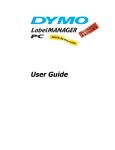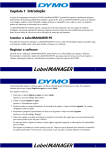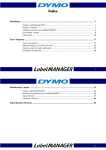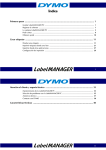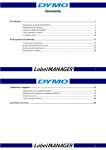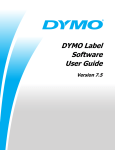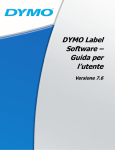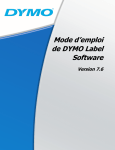Download Dymo 18949 User guide
Transcript
LabelMANAGER User Guide DYMO Corporation 44 Commerce Road Stamford, CT 06902-4561 Phone: (203) 355-9000 Fax: (203) 355-9090 Declaration Equipment Information of Conformity Description: Thermal Transfer Printer (for US models only) Model: LabelMANAGER PC (18949) This equipment has been tested and found to comply with the limits for a Class B digital device, pursuant to Part 15 of the FCC (Federal Communications Committee) rules. These limits are designed to provide reasonable protection against harmful interference in a residential installation. This equipment generates, uses, and can radiate radio frequency energy, and, if not installed and used in accordance with the instructions, may cause harmful interference to radio communications. However, there is no guarantee that interference will not occur in a particular installation. If this equipment does cause harmful interference to radio or television reception, which can be determined by turning the equipment off and on, the user is encouraged to try correcting the interference by one or more of the following measures: • Reorient the receiving antenna. • Increase the separation between the equipment and the receiver. • Connect the equipment to an outlet on a circuit different from that to which the receiver is connected. • Use shielded cables to connect this device to computers. • Consult the dealer or an experienced radio/TV technician for help. You may find helpful the following booklet, prepared by the FCC: Interference Handbook. This booklet is available from the U.S. Government Printing Office, Superintendent of Documents, Washington, DC 20402-9325. WARNING Changes or modifications to this unit not expressly approved by the party responsible for compliance could void the user’s authority to operate the equipment and void the manufacturer’s warranty. Certification This device has been tested and complies with the requirements of: UL 1950 EN60950: Low Voltage Directive Product Safety FCC Part 15 Class B EN55022: Radiated and Conducted Emissions B EN50082-1: Generic Immunity ESD, RF, and Transient Susceptibility Copyright Trademarks ©2002 DYMO Corporation. All rights reserved. 11/02 LabelMANAGER, LabelMANAGER PC, and LabelMANAGER 400 are registered trademarks of DYMO Corporation. DYMO is a registered trademark of Esselte Corporation. All other trademarks are the property of their respective holders. Contents Chapter 1 Getting Started . . . . . . . . . . . . . . . . . . . . . . . . . . . . . . . . . . . . . . . . . . . . . . . . . . . . . . . . . . . . . . . . . . . . . . . . . . . . 1 Installing the LabelMANAGER Software. . . . . . . . . . . . . . . . . . . . . . . . . . . . . . . . . . . . . . . . . . . . 1 Registering the Software . . . . . . . . . . . . . . . . . . . . . . . . . . . . . . . . . . . . . . . . . . . . . . . . . . . . . . . . . 1 The LabelMANAGER Window . . . . . . . . . . . . . . . . . . . . . . . . . . . . . . . . . . . . . . . . . . . . . . . . . . . 2 Ordering Tape Cassettes . . . . . . . . . . . . . . . . . . . . . . . . . . . . . . . . . . . . . . . . . . . . . . . . . . . . . . . . . 4 Getting Help . . . . . . . . . . . . . . . . . . . . . . . . . . . . . . . . . . . . . . . . . . . . . . . . . . . . . . . . . . . . . . . . . . . 4 Chapter 2 Making Labels . . . . . . . . . . . . . . . . . . . . . . . . . . . . . . . . . . . . . . . . . . . . . . . . . . . . . . . . . . . . . . . . . . . . . . . . . . . . . . 5 Designing a Label . . . . . . . . . . . . . . . . . . . . . . . . . . . . . . . . . . . . . . . . . . . . . . . . . . . . . . . . . . . . . . 5 Printing Labels Using Data from Another Program . . . . . . . . . . . . . . . . . . . . . . . . . . . . . . . . . . . 12 Printing from Other Applications . . . . . . . . . . . . . . . . . . . . . . . . . . . . . . . . . . . . . . . . . . . . . . . . . 14 Print Settings . . . . . . . . . . . . . . . . . . . . . . . . . . . . . . . . . . . . . . . . . . . . . . . . . . . . . . . . . . . . . . . . . 16 Chapter 3 Service and Support . . . . . . . . . . . . . . . . . . . . . . . . . . . . . . . . . . . . . . . . . . . . . . . . . . . . . . . . . . . . . . . . . . . . . . 19 Technical Support . . . . . . . . . . . . . . . . . . . . . . . . . . . . . . . . . . . . . . . . . . . . . . . . . . . . . . . . . . . . . 19 Contacting DYMO. . . . . . . . . . . . . . . . . . . . . . . . . . . . . . . . . . . . . . . . . . . . . . . . . . . . . . . . . . . . . 19 Appendix A Technical Specifications . . . . . . . . . . . . . . . . . . . . . . . . . . . . . . . . . . . . . . . . . . . . . . . . . . . . . . . . . . . . . . . . . 21 iii iv Chapter 1 Getting Started DYMO’s LabelMANAGER electronic label printers allow you to quickly print high-quality permanent labels. The LabelMANAGER PC must be connected to your computer for you to design and print labels. The LabelMANAGER 400 has a built-in keyboard allowing you to use it as a stand-alone label printer in addition to attaching it to your computer. The LabelMANAGER 400 also gives you the option of automatically cutting each label after printing. With the LabelMANAGER software, you can create labels that include borders, graphics, formatted text, barcodes, and date and time stamps. You can even print labels horizontally or vertically. When you save your label designs on your computer, you can use them over and over again. The LabelMANAGER software also supports multi-label printing with the Smart Paste and Merge Print from Database commands. The Smart Paste feature allows you to print labels by copying multiple entries from a word processor, spreadsheet, or other type of program. Merge Print from Database allows you to print labels from data in your favorite database program. Installing the LabelMANAGER Software In addition to this User Guide, the LabelMANAGER printer is shipped with a Quick Start card. Follow the instructions in the Quick Start card to install the hardware and software. Registering the Software The first time you start the LabelMANAGER application, you are asked to register the software. We highly recommend that you register your LabelMANAGER software so that you will receive customer support, information on product updates, and special announcements from DYMO. If you choose not to register the software at this time, you will be prompted the next several times you start the program. You can register the software at any time by selecting Register Now from the Help menu. To register the software 1 Select Register Now from the Help menu. The Welcome dialog box appears. 2 Click Register Now. The Registration Wizard appears. 3 Complete all of the required fields on the registration form and click Next. Required fields are labeled in bold type. 4 Answer the questions presented on the next two screens and click Next. The Registration dialog box appears. 5 Choose to register over the Internet or print the registration form for mail or fax registration. 1 Getting Started If you choose to register over the Internet, wait a few seconds while your information is transmitted to DYMO. To register by mail or fax, click Print to print the completed registration form, and mail or fax the form to the location printed on the form. The LabelMANAGER Window The LabelMANAGER software is easy to learn because the main window consists of menus and toolbars similar to those of popular word processing programs. This section summarizes the commands available to you. For more detailed information about a particular command, refer to the Help. To start LabelMANAGER ➤ Select Start > Programs > LabelMANAGER > LabelMANAGER. The LabelMANAGER main window is displayed. Standard Toolbar Formatting Toolbar Tape Settings Toolbar Rulers Text Area File Menu The following commands are available from the File menu. Toolbar Icon 2 Menu Command Description New Clears the label text. If the label has been modified, prompts you to save the changes. Open Displays the Open File dialog box to open a saved label file. If the current label has been modified and not saved, prompts you to save the changes. Save Saves the current label to disk. Save As Allows you to name the label prior to saving. Merge Print from Database Allows you to print labels directly from a .txt or .csv file. Printer Setup Displays the Printer Setup dialog box allowing access to the driver properties. Print Prints the current label. The menu command displays a dialog box asking how many copies to print. Change Printer Allows you to choose your printer if more than one LabelMANAGER printer is installed. Exit Exits the program. If the current label has not been saved, prompts you to save the changes. The LabelMANAGER Window Edit Menu The following commands are available from the Edit menu. Toolbar Icon Insert Menu Menu Command Description Undo Undoes the last action. Redo Redoes the last action after an Undo. Cut Cuts the selection to the clipboard. Copy Copies the selection to the clipboard. Paste Pastes the clipboard contents onto the label. Smart Paste Performs a multi-label paste. See “Printing Labels Using Data from Another Program” on page 12. Select All Selects the entire contents of the label. Zoom Zooms in or out on the current label. Options Displays the Options dialog box. The following commands are available from the Insert menu. Toolbar Icon Menu Command Description Symbol Displays the Insert Symbol dialog box. See “Adding Special Characters” on page 7. Date &Time Displays the Insert Date and Time dialog box. See “Adding a Date and Time Stamp” on page 9. Picture Allows you to insert a picture from the clipboard or from a file. See “Adding Graphics” on page 10. Barcode Allows you to add a barcode and it’s associated text to the label. See "Adding a Barcode" on page 10. 3 Getting Started Format Menu The following commands are available from the Format menu. Toolbar Icon Help Menu Menu Command Description Font Allows you to apply a font to the selected text. Borders Allows you to add a border around the contents of the label and may reduce the size of the text and graphics. See “Adding Borders” on page 7. Tabs Allows you to set tabs. Tape Cassette Color Allows you to select the tape cassette color combination currently in the printer to provide optimal print quality. See “Tape Cassette Color Setting” on page 16. Toolbars Allows you to show or hide the Standard, Formatting, and Tape Settings toolbars. The following commands are available from the Help menu. Toolbar Icon Menu Command Description Contents Displays the Help Table of Contents. Help Index Displays the Help Index. Register Now Displays the Electronic Registration page. About Displays the current version of the software. Ordering Tape Cassettes The LabelMANAGER printers use DYMO D1 tape cassettes. The tape cassettes are available in 1/4” (6 mm), 3/8” (9 mm), 1/2” (12 mm), 3/4” (18 mm), and 1” (24 mm) widths, and come in a variety of colors. For a complete list of D1 tapes and the names of dealers who sell the tapes, visit the DYMO Web site at www.dymo.com or call DYMO Sales. See “Contacting DYMO” on page 19. Getting Help The LabelMANAGER software includes extensive Help. At times in this manual, you will be directed to the Help for more detailed discussion or instructions on various topics. To access the Help 1 Select Contents or Help Index from the Help menu. 2 Select the topic you want to read about. The Help can also be accessed by pressing F1 in most windows and dialog boxes to display context-sensitive help. 4 Chapter 2 Making Labels The LabelMANAGER printer can print text on your labels in a variety of fonts, sizes, and styles. You can add borders, graphics, special characters, and barcodes. You can also add a date and time stamp to your labels. This chapter gives you an overview of creating and printing labels using the LabelMANAGER software. For more information on any of these features, refer to the Help. Designing a Label The instructions in the Quick Start card showed you how to print your first label. In this section, we will show you how to print a label for a file folder tab using the LabelMANAGER software. You can format the label text and then save the label for future use. When designing a label, the first items to consider are the width of the label tape onto which you will print and the length of the area where you will place the label. For this example, we will create a label that will fit on a file folder tab. The total label length must be no more than 3 1/2” (8.5 cm) and we will print on label tape with a width of 1/2” (12 mm). To create a label 1 Start the LabelMANAGER application. The main window appears. 5 Making Labels 2 Select 1/2” (12 mm) from the Tape Width pull-down menu. The text area of the main window changes in size based on the tape width you select. 3 Select Fixed At and enter 3.50 (8.5 cm) in the Label Length Fixed At text box. Notice that the size of the input area changes on the ruler. 4 Type 2002 Annual Budget Projections in the main window. As the line of text becomes too long for a fixed width label at the current font size, the font size will automatically decrease to fit the text on one line. 5 To center the text, click 6 Click . or select Save from the File menu. The Save File dialog box appears. 7 Type a name for the label and click Save. The label is saved to your hard disk with a .dlm extension automatically added to the file name. Now let’s print the label. 8 6 Click or select Print from the File menu. Designing a Label Now that you have created and saved your label, the following sections will introduce additional features you can use to customize your labels. Additional Formatting Features To further customize your labels, you can add borders, symbols, graphics, barcodes, and even date and time stamps. You can also choose to print the label vertically. Adding Borders You can choose to add one of several pre-defined borders to your label. When you add a border, it surrounds the text and may cause the text to decrease in size. To add a border 1 Place the cursor anywhere on the label. 2 Select a border style from the Borders pull-down menu. The selected border surrounds the text. If necessary, the font size of the text is decreased to fit the label. Adding Special Characters You can choose to add a special character or symbol to the label. To add a special character 1 Place the cursor at the point on the label where you want the character to appear. 2 Click on the Standard toolbar or select Symbol from the Insert menu. 7 Making Labels The Symbol dialog box appears. 3 Choose the font that contains the special character you wish to insert from the Font pull-down menu. The Symbol, Dingbats, and Wingdings fonts contain many unique characters you can add to your labels. 4 Select the symbol you wish to insert and click Insert. 5 Click Close to close the Symbol dialog box. The character you selected appears on the label in a size that matches the text font size. Adding Special Font Effects In addition to the standard font styles (bold, italic, underline, and strikeout), you can make your text stand out using a shadow or outline style. With the outline style, you choose the fill pattern. To add a shadow effect to your text 1 Highlight the text on your label that you wish to appear with a shadow effect. 2 Select Font from the Format menu. The Font dialog appears. 3 Select Shadow under Effects and click OK. The highlighted text now appears on the label with a shadow effect. 8 Designing a Label To add an outline effect to your text with a fill pattern 1 Highlight the text on your label to which you wish to apply an outline effect. 2 Select Font from the Format menu. The Font dialog box appears. 3 Select Outline under Effects. 4 Select a fill pattern from the Fill Pattern drop-down menu. 5 Click OK. The highlighted text now appears on the label with an outline effect. Adding a Date and Time Stamp You can choose to add a date and/or time stamp to the label. The date and time is entered as text and will be the actual system date and time when you added the stamp to the label. For example, if today’s date is 24 Oct 2002 and you add the date to a label design today, save the label, and then open it tomorrow, 24 Oct 2002 will still appear on the label. To add a date and time stamp 1 Place the cursor at the point on the label where you want the date and/or time stamp to appear. 2 Click on the Standard toolbar or select Date & Time from the Insert menu. The Date and Time dialog box appears. 3 Select the date and/or time format you wish to insert and click OK. 9 Making Labels The date and/or time appears on the label in the format you selected. Adding Graphics You can add a graphic to your label from the clipboard or from a file. If the graphic is in a file, the format can be BMP, JPG, PCX, PNG, TIF, WMF, or EMF. When inserted on the label, the graphic will be scaled automatically to the size of the surrounding text while maintaining the aspect ratio. To add a graphic from the clipboard 1 Copy the graphic to the clipboard from another application. 2 Place the cursor at the point on the label where you want the graphic to appear. 3 Click on the Standard toolbar or select Paste from the Edit menu. The graphic appears on the label at the cursor position. To add a graphic from a file 1 Place the cursor at the point on the label where you want the graphic to appear. 2 Click on the Standard toolbar or select Graphic from the Insert menu. The Open File dialog box appears. 3 Select the graphic file you wish to insert and click Open. The graphic you selected appears on the label. Adding a Barcode You can choose to add a barcode to your label. This feature can be very useful, for example, if you are labeling inventory items that will be scanned with a barcode reader. You can choose to print the barcode with or without the human-readable text. To add a barcode 1 10 Place the cursor at the point on the label where you want the barcode to appear. Designing a Label 2 Click on the Standard toolbar or select Barcode from the Insert menu. The Barcode Settings dialog box appears. 3 Type the text you wish displayed as a barcode in the Data field. 4 Select the type of barcode from the Symbology drop-down menu. 5 Select whether you want the actual text to appear above the barcode, below the barcode or not at all under Human Readable Text. 6 If you selected above or below, click the Font button to choose the font for the text. 7 Select the size of the barcode under Barcode Size. 8 Click OK to insert the barcode on the label. The barcode is placed on the label as a single object. To remove the barcode, you can use the backspace key or highlight the barcode and select . Printing Vertically You can print your label vertically, for example, to be placed on the spine of a binder or a video tape. When you print vertically, the text on your label is reformatted to fit in a single column on the label. You may wish to center the text on the label as well. To print vertically 1 Click in the Vertical Label check box on the Formatting toolbar to select Vertical. A warning dialog box appears informing you that the text will be reformatted. 11 Making Labels NOTE If the contents of the label are too long to fit vertically on a fixed width label, the excess content is truncated. This action cannot be undone once you click Yes. 2 Click Yes. The text of your label is now displayed in a single vertical column. Printing Labels Using Data from Another Program LabelMANAGER includes two commands that allow you to print labels from other programs: Smart Paste and Merge Print from Database. The Smart Paste command allows you to print multiple labels from a list created in a word processing, spreadsheet, or other similar program. Merge Print from Database allows you to print labels from a text or Comma Separated Value (CSV) file exported from a database program. Spreadsheet Text When copying and pasting rows of text from a spreadsheet program using Smart Paste, each row is treated as a separate label and each cell in the row is treated as a separate line on the label. For example, the rows in the following spreadsheet: will print two three-line labels: one for DYMO and one for Esselte. DYMO Corp. 44 Commerce Road Stamford, CT 06902 Esselte 48 South Service Road Melville, NY 11471 Text File Many programs can create a text file, such as a text editing program, a database application, and so on. When you export text from a database, you usually create a delimited file with each entry separated by comma or tab characters, and a carriage return/line feed at the end of each entry. Both the Smart Paste and the Merge Print from Database commands recognize the delimiter characters and will insert a line break on the label. When a comma is used as a delimiter, make sure the text that contains any commas that you want to print on the label is enclosed in quotation marks. The carriage return/line feed will start a new label. NOTE The separator character may be different for countries other than the US. When using Smart Paste, the list separator character is based on the Windows list separator (or regional setting) being used. For example, the following lines of text (delimited using commas): DYMO Corp., 44 Commerce Road, “Stamford, CT 06902” Esselte, 48 South Service Road,“Melville, NY 11471” 12 Printing Labels Using Data from Another Program will print two three-line labels: one for DYMO and one for Esselte. DYMO Corp. 44 Commerce Road Stamford, CT 06902 Esselte 48 South Service Road Melville, NY 11471 In another example, the following three lines of text are printed as three two-line labels: Pencils, 3 for $1.00 Pens, $0.50 each Erasers, $1.00 Pencils 3 for $1.00 Pens $0.50 each Erasers $1.00 Multi-Line Text from a Word Processor When copying text from a word processor, you will typically have multi-line text. In this case, the text for each label is separated by either a single blank line or a carriage return/line feed. If a blank line is contained in the text, Smart Paste reads the text as multiple labels separated by a single blank line. If no blank line is found, the text is read as multiple, one-line labels. For example, the following two addresses are separated by a single blank line and Smart Paste will print two three-line labels. DYMO Corp. 44 Commerce Road Stamford, CT 06902 Esselte 48 South Service Road Melville, NY 11471 However, the following three lines of text contain no blank lines. So, Smart Paste will print three one-line labels. Pencils Pens Erasers Printing Multiple Labels Using Smart Paste This section explains how text copied from different sources is turned into labels using the Smart Paste command. When you use Smart Paste to print multiple labels, the labels will be formatted using the font, size, and style currently selected for the label. 13 Making Labels To print multiple labels 1 Copy the text you wish to print as labels to the clipboard. 2 From the Tape Settings toolbar, select the tape width from the Tape Width pull-down menu. 3 Select the formatting for the labels from the Formatting toolbar. For example, you can change the font, size, and the horizontal position on the label. 4 Select Smart Paste from the Edit menu. A dialog box appears telling you how many labels will be printed. 5 Click OK. The labels begin printing. Printing Multiple Labels Using Merge Print from Database This section explains how to print labels by merging data exported from a database program. When you print labels using this command, the labels will be formatted using the font, size, and style currently selected for the label. To print multiple labels from a database file 1 Export the records you wish to print as labels to a CSV or text file from your database program. 2 From the Tape Settings toolbar, select the tape width from the Tape Width pull-down menu. 3 Select the formatting for the labels from the Formatting toolbar. For example, you can change the font, size, and the horizontal position on the label. 4 Select Merge Print from Database from the File menu. The File Open dialog box appears. 5 Navigate to and open the file you exported from your database. A dialog box appears telling you how many labels will be printed. 6 Click OK. The labels begin printing. Printing from Other Applications The LabelMANAGER installation wizard installs a standard Windows printer driver on your computer so the LabelMANAGER printer will appear in your list of printers. This printer can be used to print directly from other applications, such as Microsoft Word or Access, in the same manner as you would use any other printer. 14 Printing from Other Applications To successfully print to a LabelMANAGER printer, you need to set the correct page size, orientation, and margins for the tape cassette currently in the printer. Table 1 gives the paper size and margin settings for each of the label sizes supported by the LabelMANAGER printers. Table 1. Label Size and Margin Settings Paper Height Paper Width Top Margin Bottom Margin Left Margin Right Margin Address Label 1” (24 mm) 3.5” (89 mm) 0.23” (5.8 mm) 0.24” (6.1 mm) 0.4” (10.2 mm) 0.39” (9.9 mm) Large Pendaflex 0.5” (12 mm) 3.5” (89 mm) 0.09” (2.3 mm) 0.10” (2.6 mm) 0.4” (10.2 mm) 0.39” (9.9 mm) Small Pendaflex 0.5” (12 mm) 3.5” (89 mm) 0.09” (2.3 mm) 0.10” (2.6 mm) 0.4” (10.2 mm) 0.39” (9.9 mm) 1/3 File 0.5” (12 mm) 3.5” (89 mm) 0.09” (2.3 mm) 0.10” (2.6 mm) 0.4” (10.2 mm) 0.39” (9.9 mm) 1/5 File 0.5” (12 mm) 2” (51 mm) 0.09” (2.3 mm) 0.10” (2.6 mm) 0.4” (10.2 mm) 0.39” (9.9 mm) 6 mm Label 0.25” (6 mm) 3.5” (89 mm) 0.04” (1 mm) 0.04” (1 mm) 0.4” (10.2 mm) 0.39” (9.9 mm) 9 mm Label 0.375” (9 mm) 3.5” (89 mm) 0.03” (1 mm) 0.04” (1 mm) 0.4” (10.2 mm) 0.39” (9.9 mm) 12 mm Label 0.5” (12 mm) 3.5” (89 mm) 0.09” (2.3 mm) 0.10” (2.6 mm) 0.4” (10.2 mm) 0.39” (9.9 mm) 19 mm Label 0.75” (19 mm) 3.5” (89 mm) 0.11” (2.8 mm) 0.11” (2.8 mm) 0.4” (10.2 mm) 0.39” (9.9 mm) 24 mm Label 1” (24 mm) 3.5” (89 mm) 0.23” (5.8 mm) 0.24” (6.1 mm) 0.4” (10.2 mm) 0.39” (9.9 mm) Paper Name This section shows you how to print from within Microsoft Word to a LabelMANAGER printer. However, printing from applications other than Word follows the same basic steps. To print from Microsoft Word 1 Type the text to be printed into a Microsoft Word document. 2 Select Print from the File menu. The Print dialog box appears. 3 Select DYMO LabelMANAGER (PC or 400) from the list of printers, if not already selected, and click Close. 4 Select Page Setup or Print Setup from the File menu. The Page Setup dialog box appears. 5 On the Margins tab, enter the margin values for the top, bottom, left, and right margins based on the labels you have loaded in the printer. Refer to Table 1 for the correct settings. 6 Click the Paper Size tab. 7 Select the label size you have loaded in the printer from the Paper size drop-down list. 15 Making Labels The width and height values should now match the values for that label size shown in Table 1. 8 Select Landscape under Orientation and click OK. 9 Click to print the label. Print Settings This section discusses several printer settings that may optimize your printing. Tape Cassette Color Setting The LabelMANAGER printer adjusts its print settings based on the color of the label tape. To optimize the print quality, make sure you set the tape cassette color setting to match the color of the tape in the printer. To set the tape cassette color 1 Select Tape Cassette Color from the Format menu. A list of possible tape color combinations appears. 2 Select the tape color combination that matches the tape cassette in the printer. Depending upon the selection you make, the background color in the main window may change so that you get a better idea of how your printed label will look. Chain Printing When printing multiple labels, the chain printing feature will automatically print a dashed cut-line between each label to indicate where each label should be cut. DYMO Corp. 44 Commerce Road Stamford, CT 06902 Esselte 48 South Service Road Melville, NY 11471 For the LabelMANAGER PC printer, chain printing is always turned on. The LabelMANAGER 400 gives you the option of chain printing or automatically cutting each label after printing. To change the chain print setting 1 16 Select Options from the Edit menu. Print Settings The Options dialog box appears. 2 Select one of the following: • Cut each label as printed — Automatically cuts each label after printing. • Print cut marks between labels — Prints labels in a continuous stream with dotted lines between each label for cutting. 3 Click OK to apply the new setting. Label Alignment As a label is printed, blank space is added at the beginning of the label and at the end of the label. Normally, the space is the same on both ends of the label. However, you have the option of printing the label with less space at the beginning or at end of the label. DYMO Corp. 44 Commerce Road Stamford, CT 06902 DYMO Corp. 44 Commerce Road Stamford, CT 06902 Centered Left Aligned DYMO Corp. 44 Commerce Road Stamford, CT 06902 Right Aligned To change the label alignment 1 Select Options from the Edit menu. The Options dialog box appears. 17 Making Labels 2 Select an alignment from the Label Alignment drop-down menu. 3 Click OK to apply the new setting. Continuous Mode Printing Continuous mode printing prints multiple labels with no space between the labels. This is especially helpful for conserving label tape. Continuous mode printing is turned off by default. NOTE The Continuous mode printing ON selection only applies to printing from other applications. This selection has no affect when printing from the LabelMANAGER software. To set continuous mode printing 1 Select Page Setup or Print Setup from the File menu. The Print Setup or Page Setup dialog box appears depending on your operating system. 2 Click Properties. The Properties dialog box appears. 3 Select Continuous Paper ON from the Media choice pull-down menu and click OK. The labels will now print continuously with no space between labels. 18 Chapter 3 Service and Support This chapter describes how to contact DYMO for technical support. Technical Support If you experience problems with the set up or use of your LabelMANAGER printer or software, carefully read this manual and consult the Help to see if the answer is available in the documentation. If you cannot resolve your problem by consulting the documentation, you can obtain additional information at any time from the Support section on the DYMO Web site or by contacting DYMO Technical Support. See “Contacting DYMO” for a list of DYMO telephone numbers. Contacting DYMO The following table provides a list of telephone numbers to reach DYMO Sales and Support departments. You can also reach DYMO at www.dymo.com. Country Telephone Support Fax Support Australia 1800/ 633 868 1800/ 817 558 België/Belgique 02/ 713 38 08 +31/ 20/ 581 93 80 Canada (800) 263-6105 Czech Republik 02/619 12 720 +02/619 12 730 Danmark 35 25 65 08 +31/ 20/ 581 93 80 Deutschland 069/ 66 56 85 29 +31/ 20/ 581 93 80 España/Portugal 91/662 31 49 +31/ 20/ 581 93 80 France 01/69 32 49 32 +31/ 20/ 581 93 80 Hong Kong +852 2527 1928 Hungaria 1 424 6600 1 424 6601 Italia 02/ 45 28 13 08 +31/ 20/ 581 93 80 Mexico +01 5368 2066 Nederland 020/581 93 86 020/ 581 93 80 New Zealand 0800 803 966 0800 737 212 Norge 22 97 17 10 +31/ 20/ 581 93 80 Österreich 01/ 599 14 20 12 02/627-400-160 Polska 00800/311 12 50 +31/ 20/ 581 93 80 19 Service and Support 20 Country Telephone Support Fax Support Schweiz/Suisse 01/342 04 66 +31/ 20/ 581 93 80 Slovakia (+420) 2/619 12 720 (+420) 2/619 12 730 Suomi 09 229 07 04 +31/ 20/ 581 93 80 Sverige 08/ 632 00 57 +31/ 20/ 581 93 80 Turkey 212/ 286 26 30 PBX 212/ 286 26 28 United Kingdom (+44) 020/ 7341 55 29 +31/ 20/ 581 93 80 United States (203) 588-2500 Appendix A Technical Specifications The following are the technical specifications for the LabelMANAGER printers. LabelMANAGER PC LabelMANAGER 400 Print Method Thermal Transfer Print Resolution 180 dots per inch (7.09 dots per mm) Print Speed 0.4 inch per second (10 mm per second) Maximum Print Height 0.53 inch (13.54 mm) Maximum Tape Width 0.94 inch (24 mm) Computer Interface USB 1.1 Dimensions 2.5” x 5.25” x 5.25” (63.5 mm x 133.4 mm x 133.4 mm) Power Requirements 9 V DC, 1.3 A Ambient Temperature 0° C to 40° C Humidity 10% to 90% RH non-condensing Weight 1 pound, 1 ounce (0.5 kg) Print Head Life Minimum 200 cassettes (7 meters each) 4,590 feet (1.4 km) of label tape Regulatory Approvals Printer: CE, FCC Power Adapter: UL, approved by TUV according to GS standard 8.5” x 9.6” x 3.4” (215 mm x 245 mm x 85 mm) 1 pound, 9 ounces (0.7 kg) 21 Technical Specifications 22 Index A M adding barcodes 10 borders 7 date and time 9 graphics 10 special characters 7 special fonts 8 alignment, label 17 main window 2 multi-line text 13 B barcodes, adding 10 BMP 10 C cassettes,ordering 4 chain printing 16 cleaning the printer 19 contacting DYMO 19 continuous mode printing 18 creating a label 5 D database, printing 14 delimited files, printing 12 E EMF 10 F fonts, special effects 8 G graphics, adding 10 I installing LabelMANAGER 1 J JPG 10 L label alignment 17 label tape see tape cassettes O outline font 9 P PCX 10 PNG 10 print settings 16 chain printing 16 continuous mode printing 18 label alignment 17 tape cassette color 16 printer specifications 21 printing chain printing 16 continuous mode 18 from a database 14 from a list 12 multiple labels 13, 14 vertically 11 R registering the software 1 S shadow font 8 Smart Paste 12 spreadsheets, printing from 12 T tape cassettes color settings 16 widths 4 tape cassettes,ordering 4 technical support 19 text files, printing from 12 TIF 10 W WMF 10 23 24




























